Wednesday Dec 10, 2025
Wednesday Dec 10, 2025
Friday, 23 December 2022 00:00 - - {{hitsCtrl.values.hits}}
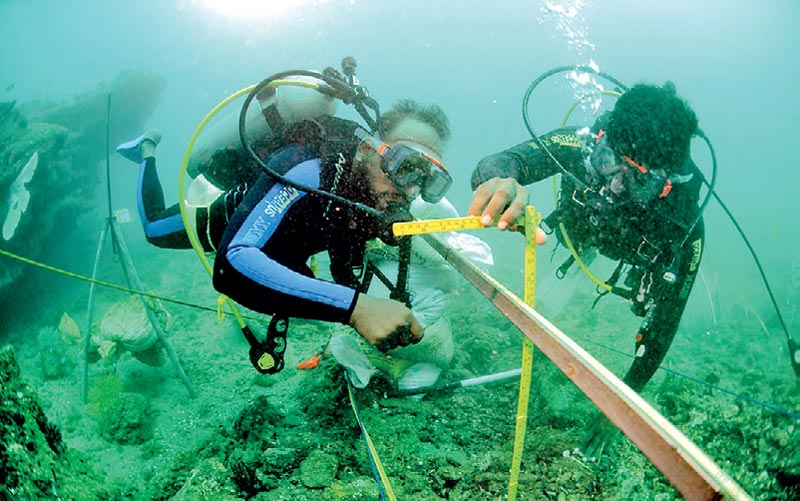
Systematic Recording
Documentation and conservation of the Godawaya shipwreck – the oldest known shipwreck in the Asia-Pacific region and one of the oldest sunken vessels to be discovered in the world, will enable insights about the seafarers and their boatbuilding traditions during ancient times and also enhance global understanding about early historic Indo-Pacific trade in which Sri Lanka played a critical role
|
By Randima Attygalle
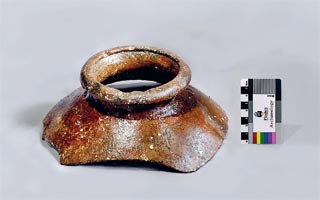 |
| Artefacts from 2014 |
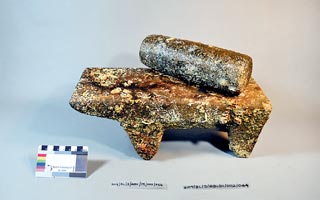 |
| Artefacts from 2019
|
US Ambassador in Sri Lanka Julie Chung announced a grant of $ 82,192 to document and conserve the Godawaya shipwreck and its artefacts at a ceremony held at the Maritime Archaeological Museum in the Galle Fort recently.
Godawaya shipwreck lying at a depth of 32 m between Godawaya (a small fishing village located near the mouth of Walave River) and Hambantota, is the oldest known shipwreck in the Asia-Pacific region and one of the oldest sunken vessels to be discovered in the world.
The grant to Sri Lanka’s Central Cultural Fund (CCF) for the documentation and conservation of the Godawaya shipwreck and its artefacts comes from the U.S. Ambassadors Fund for Cultural Preservation. Ambassador Chung remarked at the ceremony that the grant will help “preserve and promote Sri Lanka’s magnificent cultural heritage”. The exercise will also document the “important role that Sri Lanka has played as a hub for the Indo-Pacific region’s travelers and traders from its earliest days,” she said.
Since 2001, the U.S. Ambassadors Fund for Cultural Preservation has funded 15 projects here at home, totalling assistance of
$ 1,387,294. These include documentation of the Western monasteries at Anuradhapura, the conservation of the Rajagala Buddhist forest monastery, the preservation of Buddhist, Hindu, and other collections in the Anuradhapura Archaeological Museum, the restoration of the Batticaloa Dutch Fort, the preservation of the ritual music and dance forms of the Adivasi, Tamil, and Buddhist communities and the conservation of a 17th century Kandyan Kings’ Palace in Kandy.
Conserving a world treasure
The documentation and conservation funded through the grant will be undertaken by the CCF’s Maritime Archaeology Unit. “The conservation of artefacts from the wreck require considerable funds and the artefacts which we have already recovered are under treatment in our labs. It is only about 10% of the site which has been conserved and there is so much more to discover and document which entails considerable funds,” Senior Archaeology Officer from the Maritime Archaeology Unit, Rasika Muthucumarana told the Daily FT.
The depth at which the wreck lies makes the documentation process even more challenging, says Muthucumarana. “The site can be dived only by tec-divers and it requires special equipment and a special mechanism to enable a diver for a prolonged dive exceeding 20 minutes at such a depth. Each such dive which will involve a team of divers will cost quite a lot of money which our local budgets cannot afford. Due to COVID and the economic crisis, the conservation of this historically significant site was hampered and this grant will help us conserve this world treasure,” he said. Once the project has been completed, the artefacts will also be on display to the public in the Maritime Archaeological Museum in Galle.
|
Discovery of artefacts
In 2008 a team of maritime archaeologists from Galle located the site of the Godawaya shipwreck following an alert by two local conch divers who recovered a quern stone in 33 m of water about 4 km offshore which they handed over to a German archaeological team that was excavating at Godawaya. The explorations and excavations at Godawaya during the last two decades have unearthed several archaeological remains such as a temple, a harbour and also an important inscription. Close to Godawaya, there are well-known monastic complexes. The findings of excavations at these sites indicate active maritime activity in the historical and medieval periods in the port area of Godawaya.
The exploration team to the wreck comprises 12 scuba divers and about 50 dives were conducted over the course of eight days. “The site was deep and undisturbed and during our dives we recovered glass ingots, quern stones, pottery and shreds of ceramic. We also recovered a red ware jar with an out-turned rim,” recollects Muthucumarana, who was also a member of the exploration team.
According to the comparative typological evaluation, the shapes and the types of artefacts found at the Godawaya site are tentatively dated at between 2nd century BCE and 2nd century CE. Many shipwrecks, as Muthucumarana explains, are found to be having pots as cooking ware, but the high density of the potsherds at this site indicate that this vessel carried pottery as cargo.
|
Sri Lanka’s role in early trade
Relative dating and Carbon 14 dating from the wood samples found at the site indicate that the wreck is approximately 1,900 years old. However, there are still unanswered questions such as what kind of vessel was it? What was its destination and from where was it sailing? How did it sink and how was it preserved for so long? “Until we find answers to these questions we need plausible stories to fill the gaps,” says the archaeologist.
The wreck was probably a coastal trader that sailed around the country. It may have been making for the Godawaya port aiming to travel further inland towards settlements along the river. One possibility is that cargo was loaded from Godawaya and the vessel may have been heading for the east side or the far south to the Magampura settlements or this vessel may have been involved in international trade. It may have been traveling to the east coast of India or coming from India, or leaving for South-East Asia or a vessel of foreign origin.
To confirm these theories, the hull needs to be inspected through the remaining wooden parts, explains Muthucumarana. This part needs a detailed investigation not only underwater but also by taking a few samples for analysis, he says. By gaining insights about the shape and size of the hull planking and fastening will provide details about the construction methods and its origins and reveal information about the ships used during ancient trade.
“If we compare this site with other underwater archaeological sites found so far here at home, this is a site of high significance. The wreck of this period is a lone example from this part of the world. Our conclusions are still work-in-progress, so dating and cargo are still under investigation as this is an initial attempt and the story of this wreck is still being written and may change as we discover more.”
Many ships have been wrecked around Sri Lanka but Godawaya is unique with no parallel being reported in publications. The wreck will help to understand the seafarers and their boatbuilding traditions during ancient times and also increase global understanding about early historic Indo-Pacific trade in which Sri Lanka played a critical role.
Pix by Rasika Muthucumarana
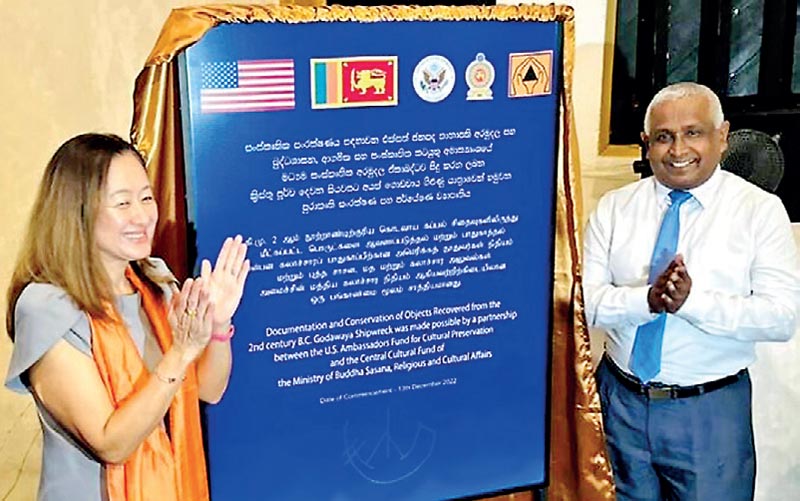
US Ambassador Julie Chung at the grant award ceremony
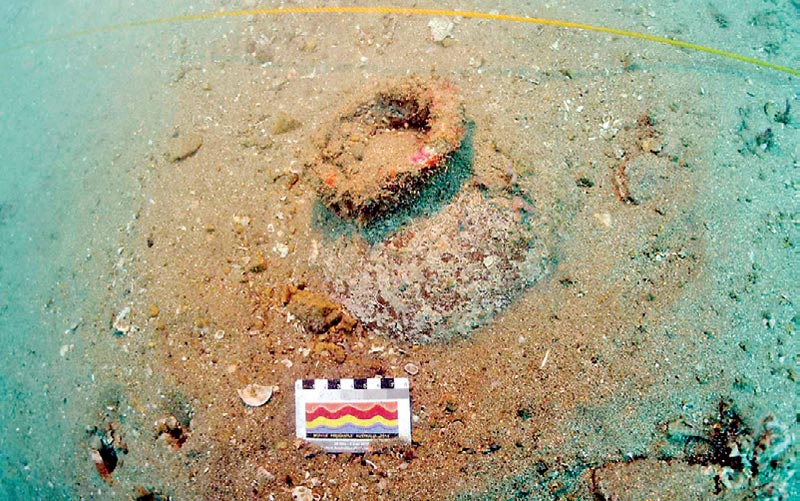
004 Pottery covered with sand
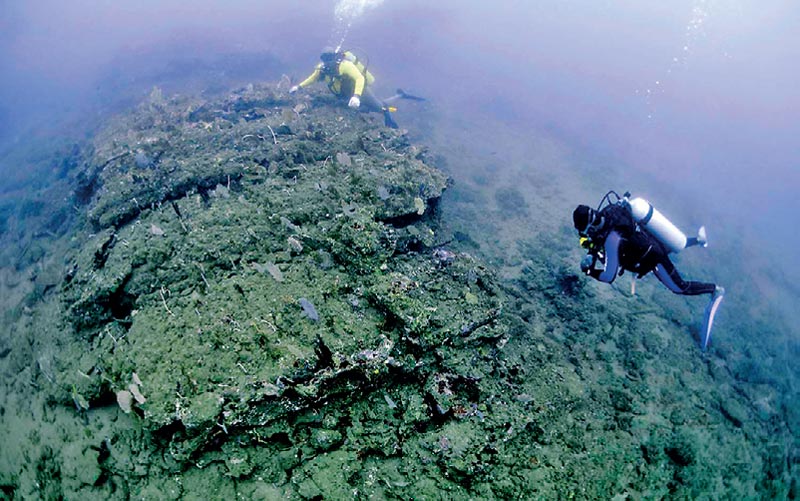
Wooden hull of the shipwreck